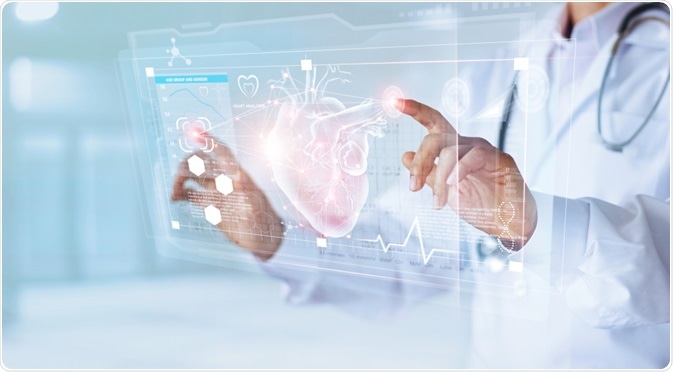Telecardiology is a modern medical practice that uses the power of telecommunications to achieve the remote diagnosis and treatment of heart disease. This includes coronary heart disease, both chronic and acute, as well as arrhythmias, congestive cardiac failure, and sudden cardiac arrest.
In this situation, doctors and other healthcare providers use electrocardiographic data, which is transmitted remotely, in real-time, for interpretation by a specialist. This enables specialist care to be accessed by people in remote locations. Advancing technology is making it easier and less expensive to set up wireless or satellite networks for this purpose, thereby increasing their effectiveness and ease.

Image Credit: PopTika / Shutterstock.com
How telecardiology works
The practice of telecardiology depends on the availability of a specialized device, which not only takes and records a 12-lead electrocardiogram (ECG) in the primary care setting but also transmits the ECG image in the form of a sound signal over the telephone line.
At the other end, namely, the telecardiology facility, this data is converted back into an image on the screen. After specialists interpret this information, an oral report is quickly sent, while a written summary is emailed or faxed to the patient hub. All ECGs are stored in an electronic database at the telecardiology center to enable future comparison of ECGs for the same patient over time.
Single-lead ECG machines are available in the form of a watch-like device to enable quick monitoring when the patient needs it while still at home. This allows for a better interpretation and diagnosis of the disease condition.
This device can store the recorded images and transmit them to the specialist once the patient reaches their doctor's office. The advantage of this approach is that the patient does not need to wait to reach the doctor’s office and can instead record the ECG as and when symptoms arise.
Benefits of telecardiology
The primary use of telecardiology is the support it gives to primary care practitioners (PCPs) in the area of correct diagnosis, thus empowering them to manage cardiac patients with increased confidence. This is advantageous for both the patient and the healthcare system.
Telecardiology also improves the clinical training of the average practitioner by increasing the clinician’s level of knowledge at the primary level. Thus, this treatment approach equips PCPs to offer better care. This applies to the diagnosis and management of pediatric heart disease, chronic cardiac failure, and emergency events like myocardial infarctions. Furthermore, telecardiology can cut down the consulting time to a quarter while also affording the patient high-quality care when it is most needed.
Telecardiology also helps enormously to reduce the percentage of missed cardiac events. For instance, the single-lead ECG device is more efficient at detecting or monitoring arrhythmias as compared to a Holter machine, as it can be worn at all times the time and can be easily switched on when the patient feels that there is something wrong with the heartbeat. This helps to detect and monitor arrhythmias during the course of treatment.
Telecardiology is very useful for long-term monitoring of multiple coronary heart disease risk factors such as hypertension or hypercholesterolemia. The results have been found to be comparable with those of face-to-face monitoring.
The availability of telecardiology has also been shown to dramatically cut down on the door-to-balloon time, which is the time that elapses between a patient’s hospital admission and angioplasty, when required. Telecardiology allows for the appropriate diagnosis to be made and allows the required personnel to be prepared for the patient even before admission, thereby cutting down on the time to surgery and preventing further muscle damage.
Telecardiology devices are small and portable, which means they can be easily moved to the patient’s bedside to make a quicker and more accurate diagnosis. Telecardiology has the proven ability to improve the quality of health care, increase cost-effectiveness, and save lives.
In conclusion, telecardiology makes the diagnosis of acute coronary events faster and more convenient, increases access to specialist care, ensures greater efficiency of patient triage and management, and lowers the burden on secondary referral hospitals.
References
- http://www.ncbi.nlm.nih.gov/pmc/articles/PMC2966883/
- http://jrs.sagepub.com/content/103/11/442.full
- http://link.springer.com/article/10.1007%2Fs10916-014-0090-5#/page-1
Further Reading